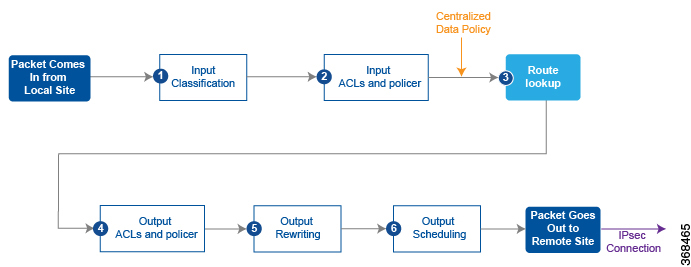The QoS feature on the
Cisco IOS XE SD-WAN devices and Cisco vEdge devices works by examining packets entering at the edge of the network. With localized data policy, also called access lists, you
can provision QoS to classify incoming data packets into multiple forwarding classes based on importance, spread the classes
across different interface queues, and schedule the transmission rate level for each queue. Access lists can be applied either
in the outbound direction on the interface (as the data packet travels from the local service-side network into the IPsec
tunnel toward the remote service-side network) or in the inbound direction (as data packets are exiting from the IPsec tunnel
and being received by the local router.
To provision QoS, you must configure each router in the network. Generally, each router on the local service-side network
examines the QoS settings of the packets that enter it, determines which class of packets are transmitted first, and processes
the transmission based on those settings. As packets leave the network on the remote service-side network, you can rewrite
the QoS bits of the packets before transmitting them to meet the policies of the targeted peer router.
Classify Data Packets
You can classify incoming traffic by associating each packet with a forwarding class. Forwarding classes group data packets
for transmission to their destination. Based on the forwarding class, you assign packets to output queues. The routers service
the output queues according to the associated forwarding, scheduling, and rewriting policies you configure.
Schedule Data Packets
You can configure a QoS map for each output queue to specify the bandwidth. This enables you to determine how to prioritize
data packets for transmission to the destination. Depending on the priority of the traffic, you can assign packets higher
or lower bandwidth, buffer levels, and drop profiles. Based on the conditions defined in the QoS map, packets are forwarded
to the next hop.
On Cisco vEdge devices and Cisco IOS XE SD-WAN devices, each interface has eight queues, which are numbered 0 to 7. Queue 0 is reserved, and is used for both control traffic and
low-latency queuing (LLQ) traffic. For LLQ, any class that is mapped to queue 0 must also be configured to use LLQ. Queues
1 to 7 are available for data traffic, and the default scheduling for these seven queues is weighted round-robin (WRR). For
these queues, you can define the weighting according to the needs of your network. When QoS is not configured for data traffic,
queue 2 is the default queue.
Rewrite Data Packets
You can configure and apply rewrite rules on the egress interface to overwrite the Differentiated Services Code Point (DSCP)
value for packets entering the network. Rewrite rules allow you to map traffic to code points when the traffic exits the system.
Rewrite rules use the forwarding class information and packet loss priority (PLP) used internally by the
Cisco IOS XE SD-WAN devices and Cisco vEdge devices to establish the DSCP value on outbound packets. You can then configure algorithms such as RED/WRED to set the probability
that packets will be dropped based on their DSCP value.
Police Data Packets
You can configure policers to control the maximum rate of traffic sent or received on an interface, and to partition a network
into multiple priority levels.
Shaping Rate
You can configure shaping to control the maximum rate of traffic sent. You can configure the aggregate traffic rate on an
interface to be less than the line rate so that the interface transmits less traffic than it is capable of transmitting. You
can apply shaping to outbound interface traffic.



 Feedback
Feedback